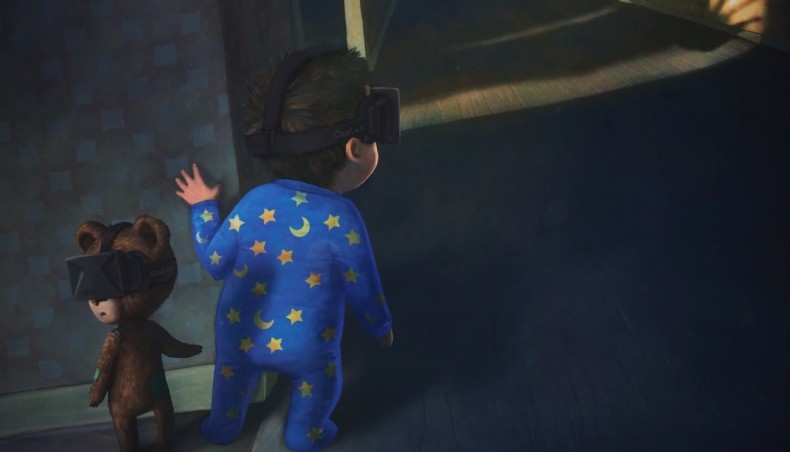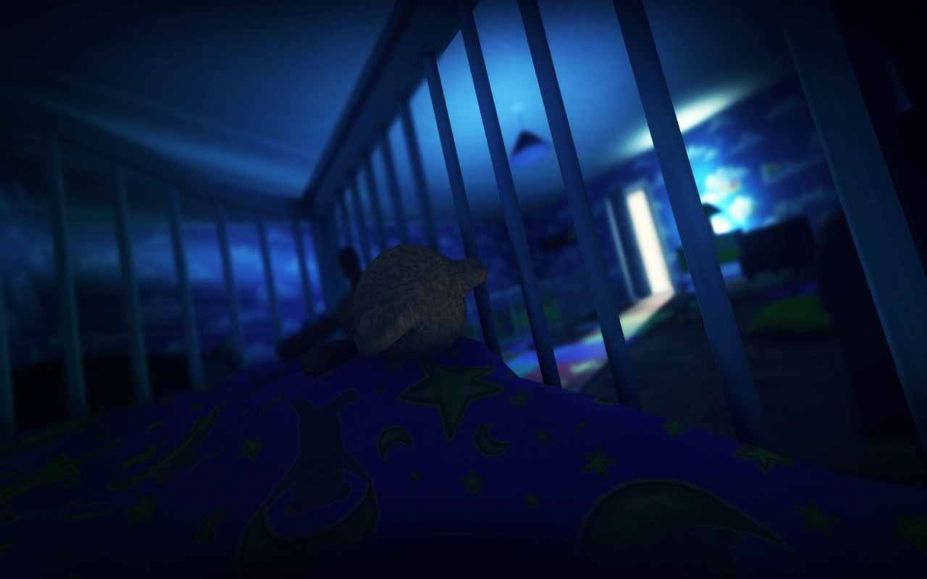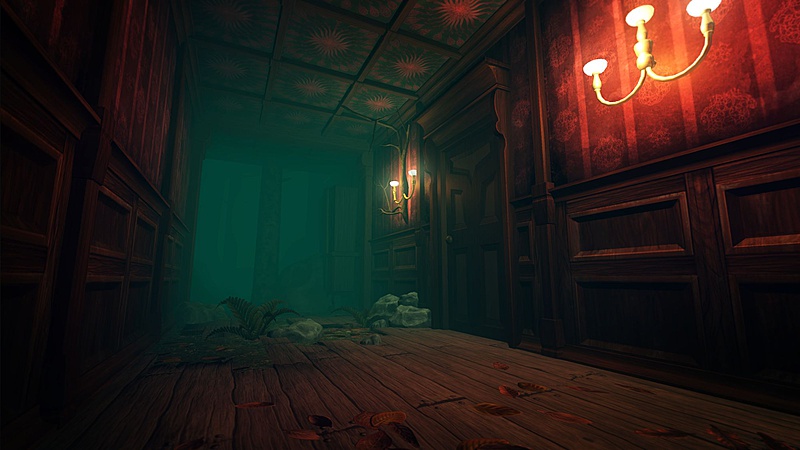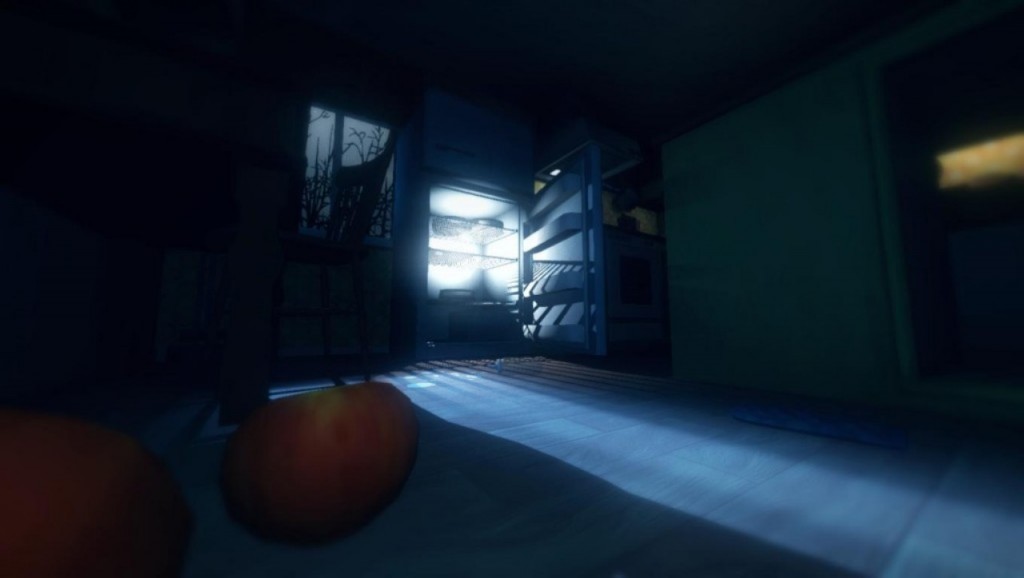Among the Sleep: Information Overload

The kind folks at Krillbite Studios were gracious enough to answer quite a few questions that the gaming public has about their upcoming game, Among the Sleep. This unique indie game, involving the adventures of a 2-year old child awakening in the middle of the night, has already stirred up quite the hype (and controversy, as you’ll read below), and the developers are hard at work optimizing the game and getting it ready to be unleashed upon the world. Time to grab your teddy bear and go crawling through their answers.
Studio and Background
Can you tell us about Krillbite Studio?
Krillbite Studio was started by 11 students, as a creative collective at the Hedmark College University in Norway. We were all studying various aspects of experience production and interactive media, and eventually decided to start collaborating on a bigger project. Thus, we started working on Among the Sleep as our thesis project.
After we graduated in 2011, we got an application for funding approved by the Norwegian Film Institute, and the company establishment was a fact. We’ve been working on the game since, while also working part-time jobs on the side to support the development.
How did the idea to play as a two-year-old child come about?
The idea was born out of the dreams of the project lead designer Anders Ugland, one night when he imagined a child fleeing from a monster in his room and hiding underneath a set of stairs – all seen in first person perspective.
He pitched the concept to the group while we were students, and just about to start working on our thesis project. Everyone instantly fell in love with the idea, and started discussing our own childhood memories and dreams. We found a lot of elements we wanted to explore, both regarding an explicit storyline about the search for safety and comfort, as well as metaphorically, related to what actually evokes the fear and confusion that the child is experiencing.
What made the child protagonist so compelling to the development team?
The perspective felt so fresh, and the possibilities so endless. A first person horror game from the perspective of a toddler is a premise everyone instantly understands – we’ve all been children after all. We’ve been scared of the dark and the unknown, and we’ve awoken from nightmares confused. We think this makes it easy for players to relate to the theme, as opposed to macho men fighting terrorists, aliens or zombies for example.
One of videogames’ obvious powers lies in placing someone in a creative context, and having them experience the resulting perspective, so the concept definitely hit a nerve with us. And based on the reactions it has caused around the web, it seems like this applies to a lot of people!
In addition, creating things we have not seen before is a central goal at Krillbite Studio. We think the medium is in grave need of more diversity, something we would love to contribute towards.
The idea was born out of the dreams of the project lead designer Anders Ugland, one night when he imagined a child fleeing from a monster in his room and hiding underneath a set of stairs – all seen in first person perspective.
How has the development process been so far?
It’s been a great and rewarding process! Going straight from our study to full time production on our very own dream project brought a steep learning curve, but we’ve come really far. It’s incredibly motivating to see how well the project is shaping up, and how many people like the look of it. As a studio we’ve only released one small creative side project before, so it’s a bit absurd to see so many people following the project, sending us emails and creating fan-art etc.
You also recently took the project to Kickstarter; can you talk a bit about why, and your experience?
We’ve been privileged enough to receive some funds from sources like the Norwegian Film Institute. But to have 11 people working on a project for over 2 years demands quite some resources, so we’ve had to work part time jobs to survive. This naturally influenced our focus and productivity on the game, something we really wanted to stop. We also wanted to stay independent and free from the creative boundaries of a publisher.
And thus, both because we love the project ourselves and because we had received some great feedback around the web, we decided crowdfunding was worth a shot. We also find the crowdfunding model very fascinating, because we as developers are in direct contact with our audience, instead of going through a middleman like publishers or investors. They have a tendency to be all too profit seeking, and even unnecessary at times.
The Game
What is Among the Sleep, for those who don’t already know? Can you briefly introduce us to the game?
Among the Sleep is a first person horror adventure, in which you play a two-year-old child. You awake in the middle of the night to mysterious sounds, and start exploring the dark with only your teddy bear as a companion. Strange things start to happen when your imagination and reality begin to blur.
We’re experimenting with a child’s perception of reality, combined with a nightmarish dream theme. A child’s physical limitations and advantages are also a central part of the experience and gameplay. For instance, an advantage of being small is that it allows you to hide in small places, but on the other hand you will also have to climb a chair to reach the doorknob.
We hope that the player is brought back to their childhood – not understanding what is going on, but always exploring how the world works. We also want to set their imagination in spin. When you hear things you can’t place or recognize, your mind automatically fills in the gaps – and our graphics will never compete with people’s own imagination.
We want to explore horror through tense atmosphere and exploration, not high scores and combat systems. And we’re working hard to make the player feel present in the world, by for instance having a visible body at all times. Seeing your small hands crawl on the floor while hiding under the couch makes for a quite unique experience!
But even though all of this research provides a lot of inspiration, we don’t limit ourselves by realism. We don’t want to make a baby simulator; we want to make a creative experience for adults.
Have you done any research on children? Or are you just taking more of a creative approach to it?
We combine a creative and research-based approach. For instance we’ve been in contact with people of competence within the field of child development and psychology, as well as reading books and doing research ourselves. In addition we’ve been recording footage of nephews and the like for animation and behavior related research.
But even though all of this research provides a lot of inspiration, we don’t limit ourselves by realism. We don’t want to make a baby simulator; we want to make a creative experience for adults. In addition, the perspective, imagination and dream theme provides a lot of creative freedom to do exactly what we want, something we certainly do.
What are your influences and inspirations?
We draw inspiration from all over the place! Everything from the Shining, to Alice in Wonderland, Lovecraft’s work or child psychology & development – a lot of things have influenced the game in one way or another. But we also have a strong wish to create something completely unique, so we try to draw most of our inspiration from our own dreams and childhood memories. We also hope that this will make the game more personal, something a project with huge teams and budgets often have hard time achieving.
Regarding gameplay, a specific example is Amnesia, which was released a while into the production of Among the Sleep. It really reinforced our belief that our passive protagonist would work out in practice. Frictional Games demonstrated that a game without competitive mechanics (like combat or scores) would work just as effectively (if not more effectively!) in a horror setting.
You wrote a blog post addressing the controversy surrounding playing a child in a horror game. Have you received a lot of negative feedback on that topic?
Not much yet, but when some people hear ‘Videogame’, ‘child’ and ‘horror’ in the same sentence, a few misunderstand the concept. Some have been concerned that we are using bad taste as a marketing tool, or the child protagonist simply as a gimmick to provoke. We’ve even been reluctant to describe it as a horror game externally sometimes, because many people associate ‘horror’ with brutality and gore, which doesn’t describe Among the Sleep at all.
The blog post mentioned was written so that we would have a direction to point these people, in case it became a problem. We’re not really expecting that though, and even if it did become a problem we don’t really worry. Content categories, like sex, violence or children, are not bad taste in themselves – only the way it’s presented can be.
Is this story driven? How do players progress through the game and are there any non-linear elements to the experience?
It’s definitely story driven, both through a compelling plot and metaphorically – related to what actually evokes this fear and confusion in the child. But we’d rather not go into detail regarding the story, as exploration and wonder is quite central to the experience. We can say as much as that your goal throughout the game is the search for safety and comfort.
Regarding non-linearity, we definitely want the game’s systems to observe the player and respond to that. It’s crucial that players do not see a system that can be fooled, but instead feel that there are real threats to hide from. At the same time we’re encountering a few design challenges – a system like this is easily reproduced for many similar levels, but as you can see in our Environment Teaser, we want to keep Among the Sleep as diverse and varied as possible! Not only in how threats behave, but all over, and we don’t want any filler content. Conclusion – we’re still experimenting.
Can you tell us more about the child’s Teddy Bear? What is its role in the game?
Teddy has a significant role as a story-driving companion, mostly hanging on your back and occasionally talking. At times he will also factor into the gameplay to a certain degree, providing comfort and temporary safety. I’d like to stress that he will mostly be hanging on your back though, so he will not be an frustrating AI character that stands in your way, or attracts threats etc.
You mentioned that the avoidance of combat (for lack of an effective defense) was key, how interactive will hiding be? I.E. Will the main character be able to enter closets etc.?
Definitely! We’re aiming to make the environment as interactive as possible, so for instance you’ll be able to push, pull and climb objects, open and close doors and cupboards, make a staircase out of drawers, peek around corners, carry and place small objects, and the list goes on. These abilities will be used actively in hectic situations, to find hiding spots to stay safe for example.
Will there be a large variety of environments to explore?
The house in the gameplay teaser and alpha is only one of the earliest chapters, and you will be traveling a long way from home before the end. The environments are also inspired by the surreal and unpredictable nature of dreams and imagination, so it will range from things like the house you saw in the gameplay teaser, to an abandoned playground inside a dark cave. With a setting like this we have no reason to limit our creativity!
We can say as much as that your goal throughout the game is the search for safety and comfort.
In AtS players can choose to walk or crawl. How does this affect the way game plays? Is there more to it than just to crawl into small spaces etc.?
Definitely! One example is that you generally crawl faster than you walk because you’re still a bit unsteady on your feet. But at the same time, while standing you’ll be able to run for a few meters if you’re in a real hurry (if you don’t stop after that you’ll topple over!). In addition, you will have to stand upright to drag chairs and other larger things around, but suddenly you’ll have to crawl under a table to hide as you suggested. So yes, the player will be forced to switch between the different ‘stances’ actively to survive and progress.
Is it challenging to find ways to create tension that don’t rely on the possibility of combat?
Threats will still leap at you from the shadows, so removing combat only changes what actions you must perform to overcome them. We feel that combat systems are exactly that, systems. People will often master it, or be frustrated by it, either way the horror disappears. Instead, players will have to explore and find places to hide and avoid confrontation, which also maintains the crucial mystique of horror. You’ll be thinking “What was that thing!?†instead of getting time to study every creature.
How many hours of gameplay can we expect?
We estimate minimum 4 hours of gameplay in the finished game, though this might change in the continued development. We’re quite critical to the quality of what makes it into the game, and we don’t want any unnecessary filler content. Also, we are a small team of indie developers with limited resources! What we lack in playtime, we hope to substitute with quality and creativity.
On which platforms will AtS be released?
We want as many people to be able to play Among the Sleep as possible! It will definitely be released for PC, MAC & Linux, and our dialogues with sony about a possible PS4 is going good as well (no promises!). We just got the game greenlit on Steam, and we’re also finalising the details regarding a GOG release. In addition we will be offering a completely DRM-free version through paypal / amazon from our own website.
Can you talk a bit about the role of sound in the game? It seems like it plays a strong role in terms of both adding to the scariness but also guiding the player along.
Sound is definitely a crucial part of Among the Sleep, and we even consider it around 70% of the experience! We want the sound to set the players own imagination in spin, like a scared child. When you hear things you don’t recognize or can’t place, your mind automatically fills in the gaps, and our graphics will never compete with people’s own imagination. The more things our players create in their heads to substantiate the things we throw at them, the better!
You’ve announced Oculus Rift support for Among the Sleep. What made you interested in this technology?
The immersion it offers! It’s surprising how big a difference there is between a traditional flat screen and the sense of depth and isolation from the outside world the Rift offers. It reminded me a bit of scuba diving, in that you almost forget there is another world out there. As you can see in the announcement video, we have a quick test of Among the Sleep running already. We can definitely confirm that looking down at your own baby body, or up at the door handle towering high above you, is quite a special experience while wearing the Rift. Also, the added tracking for orientation adds a physical connection to the game unlike anything we’ve experienced.
The sense of perspective the Rift achieves, makes playing a two year old child an even more unique and tangible experience. The sense of scale it adds, also makes everything more firm and relatable, and the child‘s perspective more genuine. At last the isolation from the outside world, makes for a even more immersive experience.














